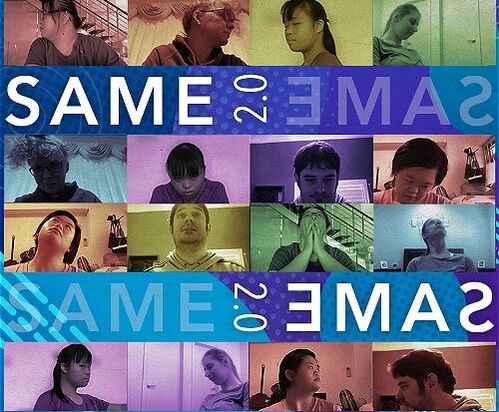Sean Burnett Dugdale-Martin
I’m tucked in bed waiting to be put through from the Zoom waiting room into the show when I receive a message in the waiting room chat window: “Thank you for being on time! We’ll be ready in a few moments.” Some members have tuned in from Singapore, some from Adelaide in Australia, and it’s a sign of a tight ship when everyone who’s meant to be in the call is actually in the call and no one has bad connections, freezes, or drops out. This bodes well for a work that was first commissioned in 2020 and has been in development since Fringe 2021.
As the audience is ushered into the zoom (zushered?) we are met by the two bubbly, excited MC’s: Jeffrey Tan (Open Homes) and Andi Snelling (Happy-Go-Wrong), who welcome everyone entering. They thank us for arriving, give thanks to everyone who has helped the show happen and all those who have come before so that we all may be here now. What I can only describe as cool circus/elevator music plays as we are encouraged to follow along with the cast in a low-intensity physical warm up. So far the piece is both odd and lovely, but the more time I spend in the Zoom, the less odd it becomes and the more joyous.
The cast of six (Kobi Taylor, Jack Sadler, Weng Jiaying, Megan Tang, Chen Wanyi, Zoe Walker) are magnetic in their truthfulness. Upheld by Tan and Snelling, the cast are empowered to be themselves which is alluring as an audience member because the people these performers are, aren’t often represented in most media we consume because of their unique, diverse abilities. This is one of the elements that makes this show so joyous. It’s theme of celebrating friendship across borders doesn’t only refer to closed borders between countries during the pandemic but also the border of ability that we’ve been socially trained to adhere to.
Later in the show the cast performs an interpretive dance to a piece of music and we, the audience, are invited to type words that come to mind in the chat, inspired by the dance. Afterwards, a word is chosen from those given and the cast then improvises a verbal story based on that word. Not only is this another chance for the cast to show off their sense of humour (particularly Pun Master Kobi Taylor who spun the chosen word of ‘connection’ into looking for a multiboard to plug into) but also, on a deeper level, demonstrates the connections we can have across our various countries. The team shows how audiences and performers can interact with each other seamlessly as the production flexes its knowledge of the Zoom toolbox (zoolbox? I’ll stop). I had no idea you could do polls on Zoom? There was some invisible person/people in charge of making sure who’s video feed should be on the main screen, making sure the music was playing correctly and at the right level. It even surprised me that they could send me messages while I waited in the waiting room?
If I were left wanting for anything it would be for the cast to improvise together more. What was performed was constantly fun and unexpected but perhaps time-wise it was outweighed by the 25ish minutes spent introducing the cast. That being said, if my only criticism is more of what you did, then two years of development has paid off. The most wholesome and pure show I’ve seen in a long time is also one of the most accessible with links posted in the Zoom chat that take you to a LiveNotes page where William Ch’ng, Nicole Ang and a Google profile simply named Evelyn write a live transcript of the show.
SAME-SAME 2.0: An Online Performance is a part of the 2022 Fringe Festival and is probably going to be wrapped up by the time this review comes out (if not, find tickets here). However, it is also a part of the 2022 Adelaide Fringe Festival where you can also view it from the comfort of your own home in March. Tickets available here.






